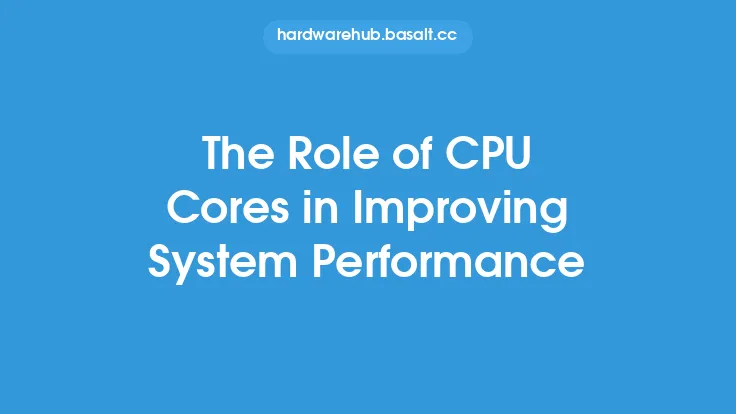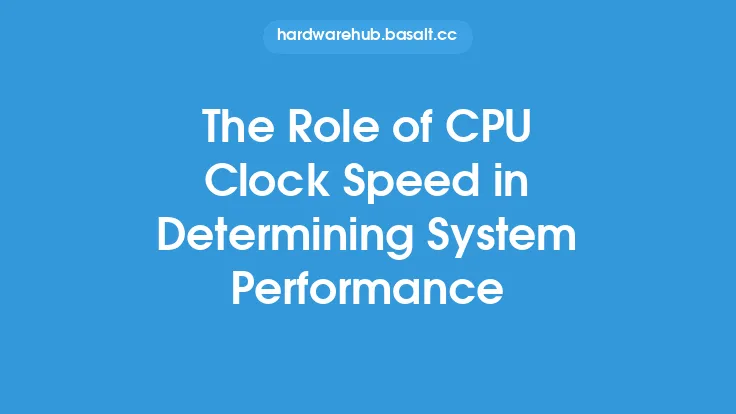The central processing unit (CPU) is a critical component of modern computing systems, responsible for executing instructions and handling tasks. One of the key technologies that has improved the performance and responsiveness of CPUs is multi-threading. In this article, we will delve into the role of CPU multi-threading in improving system responsiveness, exploring the technical aspects and benefits of this technology.
Introduction to CPU Multi-Threading
CPU multi-threading is a technique that allows a single CPU core to execute multiple threads or processes concurrently. This is achieved by dividing the CPU's execution resources, such as registers and execution units, among multiple threads. Each thread is allocated a specific time slot, known as a time quantum, during which it can execute instructions before being switched out for another thread. This switching process is known as context switching.
How CPU Multi-Threading Improves System Responsiveness
CPU multi-threading improves system responsiveness in several ways. Firstly, it allows multiple tasks to be executed simultaneously, reducing the time it takes to complete tasks and improving overall system throughput. When a thread is waiting for input or output operations, such as disk access or network communication, the CPU can switch to another thread, ensuring that the system remains responsive. This is particularly important in systems with multiple users or applications, where responsiveness is critical.
Technical Aspects of CPU Multi-Threading
From a technical perspective, CPU multi-threading relies on several key components, including the thread scheduler, context switcher, and execution units. The thread scheduler is responsible for allocating time quanta to each thread, while the context switcher handles the switching of threads. The execution units, such as the arithmetic logic unit (ALU) and floating-point unit (FPU), execute the instructions of each thread. Modern CPUs often feature multiple execution units, allowing for simultaneous execution of multiple threads.
Benefits of CPU Multi-Threading
The benefits of CPU multi-threading are numerous. It improves system responsiveness, reduces latency, and increases throughput. Additionally, CPU multi-threading enables better utilization of system resources, such as memory and I/O devices. By executing multiple threads concurrently, the CPU can minimize idle time, reducing power consumption and heat generation. This is particularly important in mobile devices and data centers, where power efficiency is critical.
CPU Multi-Threading in Modern Computing Systems
In modern computing systems, CPU multi-threading is a ubiquitous feature. Most operating systems, including Windows, Linux, and macOS, support multi-threading, and many applications, such as web browsers and office software, are designed to take advantage of this technology. Additionally, many CPUs, including those from Intel and AMD, feature multi-threading capabilities, such as Simultaneous Multi-Threading (SMT) and Hyper-Threading.
Challenges and Limitations of CPU Multi-Threading
While CPU multi-threading offers many benefits, it also presents several challenges and limitations. One of the primary challenges is thread synchronization, which ensures that multiple threads access shared resources correctly. Additionally, CPU multi-threading can increase power consumption and heat generation, particularly in systems with multiple CPU cores. Furthermore, the complexity of multi-threaded programming can make it difficult for developers to optimize applications for multi-threading.
Best Practices for Optimizing CPU Multi-Threading
To optimize CPU multi-threading, developers and system administrators can follow several best practices. Firstly, they should ensure that applications are designed to take advantage of multi-threading, using techniques such as parallel processing and thread pooling. Additionally, they should optimize thread synchronization, using techniques such as locks and semaphores, to minimize overhead. Finally, they should monitor system performance, using tools such as performance counters and profiling tools, to identify bottlenecks and optimize system configuration.
Conclusion
In conclusion, CPU multi-threading plays a critical role in improving system responsiveness, enabling multiple tasks to be executed concurrently and reducing latency. By understanding the technical aspects and benefits of CPU multi-threading, developers and system administrators can optimize applications and systems to take advantage of this technology. While CPU multi-threading presents several challenges and limitations, best practices such as thread synchronization and performance monitoring can help to minimize these issues. As computing systems continue to evolve, CPU multi-threading will remain a critical technology, enabling faster, more responsive, and more efficient computing.





